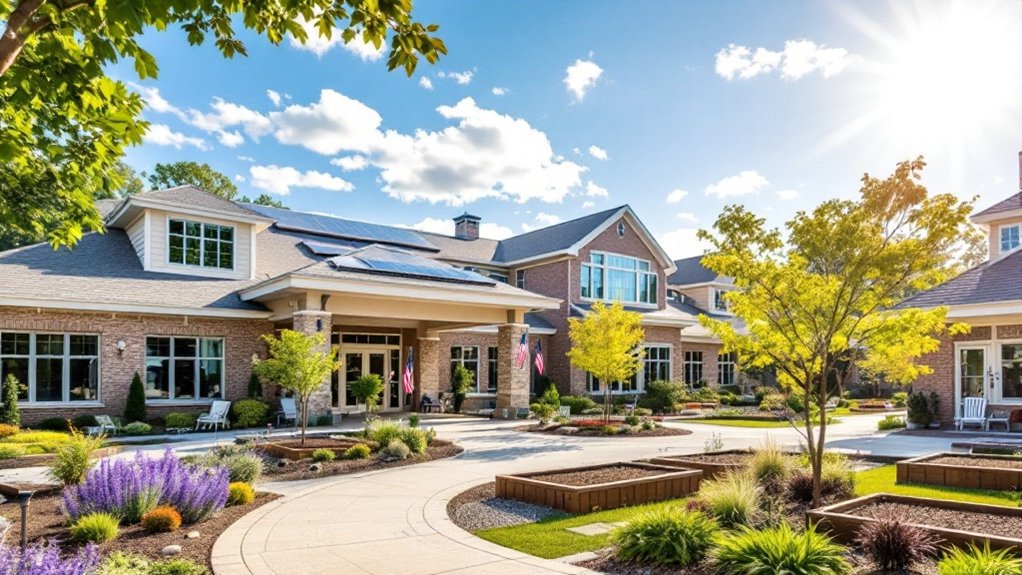You'll find expanded access to VA-supported assisted living through the transformative Veterans' Long-Term Care Act pilot program, which delivers 43% cost savings versus traditional nursing homes. The Aid and Attendance Program and Veteran Directed Care Program provide customizable support within VA Health Care Benefits, while State Veterans Homes offer extensive services including domiciliary care and adult daycare. Further exploration reveals additional financial advantages and facility innovations optimizing veteran care delivery.

Three groundbreaking pieces of legislation are reshaping assisted living options for America's veterans, with the Senator Elizabeth Dole 21st Century Veterans Healthcare and Benefits Improvement Act leading transformative changes in long-term care accessibility.
The House passed this legislation with overwhelming support through a 382-12 vote.
The Expanding Veterans' Options for Long-Term Care Act has further catalyzed this transformation, establishing a pilot program that's projected to generate annual savings of $69,101 per veteran compared to traditional nursing home care.
The Veterans' Long-Term Care Act pilot program delivers substantial savings while revolutionizing care options for those who served our nation.
You'll find substantial financial support through the Aid and Attendance Program if you need assistance with daily living activities, while the Veteran Directed Care Program enables you to select and hire caregivers tailored to your specific needs.
These programs operate within a framework of VA Health Care Benefits, requiring wartime service periods and specific financial and medical qualifications for eligibility.
The VA benefits application process requires thorough documentation and can significantly improve access to quality assisted living care.
State Veterans Homes offer an extensive spectrum of care options, including domiciliary care, nursing services, and adult daytime programs, all operating under stringent VA approval standards.
Your access to these facilities varies by state, with services specifically designed to accommodate regional veteran populations and their unique requirements.
The economic advantages of assisted living facilities are particularly compelling, as they operate at approximately 43% of nursing home costs, while providing comparable quality of care.
This cost-effectiveness becomes increasingly significant given the projected 535% increase in veterans eligible for nursing home care over the next two decades.
Construction and development of veteran-focused assisted living facilities now incorporate sophisticated accessibility requirements and support services, informed by thorough market analyses and operational cost projections.
Modern facilities prioritize the implementation of sustainable building practices to reduce long-term operational costs while enhancing resident comfort.
You'll find these facilities are strategically designed to maximize both cost efficiency and care quality, with careful consideration given to ongoing operational expenses including utilities, maintenance, and staffing requirements.
The integration of VA benefits understanding into facility design ensures that construction managers create environments specifically optimized for veteran care delivery, representing a significant advancement in long-term care infrastructure.
Frequently Asked Questions
What Mental Health Support Services Are Available for Veterans in Assisted Living Facilities?
You'll find extensive mental health support through VA-partnered counseling services, group therapy sessions, and specialized PTSD programs within assisted living facilities.
These services integrate with facilities' existing social activities, memory care units, and professional mental health staff.
You can access VA telehealth services, individual therapy sessions, and peer support groups, while family caregivers receive guidance for supporting your mental well-being.
Can Veterans With Service Dogs Live in Assisted Living Communities?
You can live in assisted living communities with your service dog, as these facilities must comply with the Americans with Disabilities Act (ADA) regulations.
However, you'll need to verify that your dog meets the VA's service animal requirements, including specific task training for your disability.
While policies vary by facility, you're entitled to reasonable accommodations, though emotional support animals typically don't qualify for protected status.
Are There Special Programs for Veterans With PTSD in These Facilities?
Yes, many assisted living facilities offer specialized PTSD programs through their partnerships with Warrior Care Network and VA healthcare services.
You'll find intensive outpatient treatments combining traditional therapy with holistic approaches like yoga and art therapy. These programs typically provide 50+ hours of direct PTSD treatment, and facilities often incorporate Project Odyssey's adventure-based learning methods into their therapeutic offerings.
Accommodations are made for service dogs as part of extensive care plans.
How Do Veterans Transfer Their VA Benefits Between Different Assisted Living Facilities?
To transfer your VA benefits between assisted living facilities, you'll need to coordinate directly with your VA benefits coordinator and submit Form 21-2680 to verify continued eligibility.
You must ascertain the new facility is VA-approved and can provide your required level of care.
Your Aid and Attendance benefits remain portable, though you'll need to confirm the new facility accepts VA payment arrangements and meets VA's quality standards before transferring.
What Transportation Services Are Provided for Veterans to Visit VA Medical Centers?
You'll have access to multiple transportation options through the VA, including the Veterans Transportation Service (VTS) for door-to-door assistance and DAV vans for no-cost rides.
The Beneficiary Travel Program reimburses your expenses when using private vehicles or public transport.
You can schedule rides 48-72 hours before appointments through your local VA center, with priority given if you have disabilities or live in rural areas.









